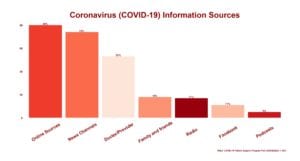Learn more about our FREE COVID-19 Patient Support Program for chronic illness patients and their loved ones.
Early in the pandemic, the Global Healthy Living Foundation (GHLF) started an online COVID-19 Patient Support Program to provide news, information, advice, and support for people living with chronic illness. The program is free and you can still sign up here.
Members of our program have underlying health issues — such as inflammatory arthritis and other autoimmune conditions, heart disease, lung disease, diabetes, and more — that may increase their risk for COVID-19 complications. They are interested in understanding the best ways to stay safe during the pandemic and to be part of a community of people with similar concerns, questions, and fears.
We regularly poll members, who live in the U.S. as well as around the globe, about a variety of topics, including how the pandemic is affecting their lifestyle, mental health, chronic disease management, medication adherence, and more.
We use this information to inform the educational resources we provide and to inform other stakeholders — such as public health experts, policymakers, advocacy groups, health care professionals, and pharmaceutical companies — about chronic illness patients’ needs and concerns.
Here are the results of our poll about where our members get their coronavirus (COVID-19) information from.
Conducted: December 8-11, 2020
Number of respondents: 387
What We Asked
The coronavirus (COVID-19) pandemic has drastically increased the demand for health information. Balancing misinformation with fact- and science-based information has been a challenge throughout the pandemic. With that in mind, we wanted to ask our patient community where they receive their health information regarding COVID-19.
We asked:
- Where do you get your information on COVID-19 (other than this email subscription)?
We were also interested to know how often our members get health information from those sources and how that compared to their pre-pandemic habits by asking:
- How often do you get coronavirus (COVID-19) information from those sources?
- Compared how to how often you used to get health information from those sources before the pandemic, how often do you get information from those sources now?
Many of our Patient Support Program members live with underlying conditions that may put them more at-risk for serious health complications if they contract coronavirus (COVID-19). We therefore wanted to understand more about respondents’ satisfaction with their information sources’ coverage of the COVID-19 specifically as it relates to people with underlying health conditions.
We asked:
- How satisfied are you that the coronavirus (COVID-19) information you get talks about the pandemic’s effect on people with underlying health conditions?
What We Learned
There were 387 respondents to the poll. Of those respondents, many used similar sources for their health and coronavirus (COVID-19) information.
The most common sources included the following (participants were able to select more than one response):
- 80%: Online sources (CDC, World Health Organization, state health department, etc.)
- 74%: News channels (NBC, Fox, CNN, Newsmax, etc.)
- 53%: Doctor or other health care provider
- 18%: Family and friends
- 17%: Radio
- 11%: Facebook
- 5%: Podcasts
It was less common for our members to use social media sources such as Twitter, Instagram, and YouTube to get health information (less than 5 percent).
How Often Patients Use These Sources
A vast majority of respondents expressed they access these sources for health information daily (61 percent). Beyond that, members used these sources at the following rates:
- 29%: Often (multiple times a week)
- 9%: Sometimes (weekly)
- 1%: Rarely (a few times a month)
How Often Patient Use These Sources Relative to Before the Pandemic
Many of our members live with underlying health issues and have been following COVID-19 news closely. We believe this is because they are seeking information to help themselves stay safe and avoid infection and complications.
The majority of poll respondents have increased how often they use these sources for health information. Here are how their habits have or have not changed:
- 59%: Spend more time getting information from those sources now than before the pandemic
- 27%: Spend about the same amount of time getting information from those sources now as before the pandemic
- 8%: Did not get information from those sources before the pandemic
Only 6 percent of respondents spend less time getting information from these sources now than before the pandemic.
Level of Satisfaction with Coverage for People with Underlying Health Conditions
Respondents’ satisfaction with how their COVID-19 information sources address the ways the coronavirus affects those with underlying health conditions varied. The levels of satisfaction are as follows:
- 51%: Moderately satisfied
- 32%: Not at all satisfied
- 17%: Very satisfied
When grouped by different information sources, the levels of satisfaction are very similar across the board. This shows that no matter where our members get their coronavirus (COVID-19) information from, they are similarly content (or not) with coverage of how COVID-19 is affecting those with underlying health conditions
What This Tells Us
Between the information our members receive from the GHLF Patient Support Program and news from our respondents’ most common source — trusted public health sites such as the CDC and the WHO — it is clear that our members are committed to getting accurate information about the pandemic.
Ensuring access to accurate information is a priority of the GHLF Patient Support Program, where we have committed to educating and empowering our members. We will continue to provide and accurate information catered to those living with chronic illness and underlying health issues as the pandemic continues.
Get Free Coronavirus Support for Chronic Illness Patients
Join the Global Healthy Living Foundation’s free COVID-19 Support Program for chronic illness patients and their families. We will be providing updated information, community support, and other resources tailored specifically to your health and safety. Join now.







